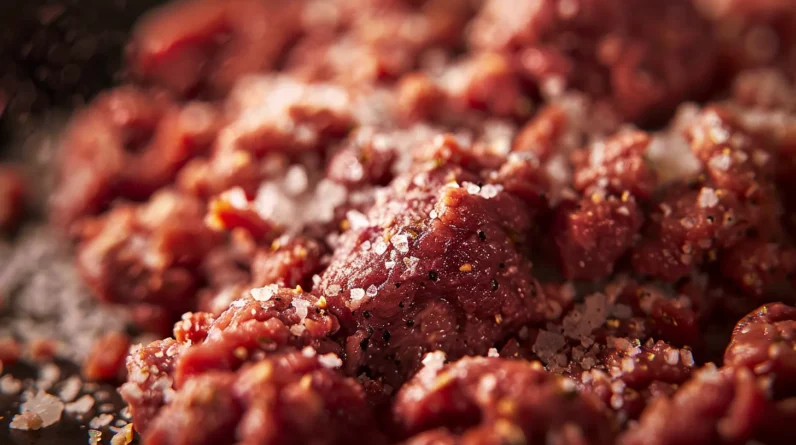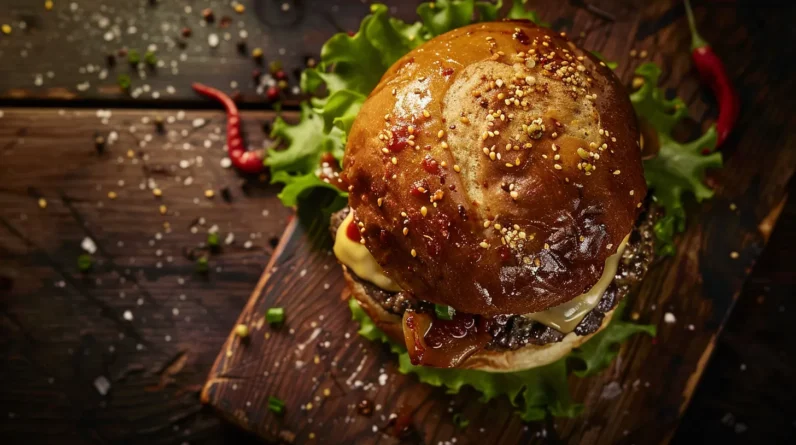
We’ve found that salt timing substantially impacts ground beef’s flavor and texture, as it affects penetration and protein interaction. We use about ½ teaspoon of flake kosher salt per pound for ideal flavor. Salting methods, like surface or mix-in, yield distinct results. By understanding salt’s role, we can refine our approach to achieve the desired outcome, and exploring this further will reveal more about the science behind seasoning ground beef.
Salt Timing for Flavor Penetration
As we explore the concept of salt timing for flavor penetration, we recognize that controlling the timing of salt application is essential for achieving the desired flavor profile in ground beef. We’ve found that penetration rates are critical for flavor enhancement, as salt interacts chemically with meat proteins. Allowing salt time to penetrate enhances internal flavor uniformity, leading to more intense, stable beef flavor. Understanding penetration rates enables us to optimize salt timing, resulting in improved flavor enhancement and a more balanced taste experience. This knowledge helps us master the art of seasoning ground beef.
Effects of Salt Timing on Texture and Juiciness
When we apply salt to ground beef, it dissolves muscle proteins, substantially affecting texture and juiciness. We observe that salt timing influences protein binding, which in turn affects texture formation. Early salting promotes tighter protein networks, leading to a firmer texture. In contrast, salting after patty formation preserves tenderness by minimizing excessive protein binding. This balance is vital for ideal texture and juiciness. We must consider protein binding and texture formation when determining salt timing to achieve the desired texture in our ground beef dishes. Proper salt timing helps us control protein coagulation, resulting in a softer, more tender final product.
Recommended Salt Quantities for Ground Beef
We’re focusing on the amounts of salt to use in ground beef, building on our understanding of how salt timing affects texture and juiciness. We’ve found that approximately ½ teaspoon of flake kosher salt per pound is a good starting point. Fine-grain salts require less, around ¼ teaspoon per pound. Salt preferences play a significant role in flavor enhancement, so we adjust quantities accordingly. For ideal flavor, we aim to balance salt levels, considering the type of salt and desired saltiness. This balance guarantees we enhance the natural flavors without overpowering them, allowing for precise control over salt preferences and flavor enhancement.
Salting Methods Relative to Ground Beef Preparation
To optimize the salting process for ground beef, it’s crucial that we recognize how different salting methods impact the final product. We consider our salt preference and its effect on meat storage. Salting before or after forming patties yields distinct results. Surface salting retains moisture, while mixing salt in beforehand can lead to a denser texture. We must balance our technique to achieve the desired outcome, taking into account the impact on moisture and texture. By understanding these methods, we can refine our approach to salting ground beef, ensuring ideal flavor and texture in our final product.
Salt Impact on Food Safety and Handling
Salt’s impact on food safety and handling is a multifaceted issue that builds on our understanding of salting methods and their effects on ground beef. We recognize that salt plays a pivotal role in food preservation by reducing water activity, which limits microbial growth. Effective microbial control is essential for preventing the growth of pathogens like Listeria monocytogenes and Salmonella. By maintaining ideal salt concentrations, we can inhibit these microbes, ensuring safer handling and storage practices. This understanding is essential for balancing sodium reduction with food safety concerns in ground beef formulations.
Scientific Mechanisms Behind Salt and Meat Interaction
As we explore into the scientific mechanisms behind salt and meat interaction, it’s clear that the dynamics at play are complex and multifaceted. We’re dealing with protein denaturation, where salt ions disrupt native protein structures in muscle fibers. Meat composition plays a vital role, as sodium and chloride ions interact with proteins, increasing solubility and water retention. This leads to improved texture and binding properties. The effects of salt on protein denaturation and meat composition are intertwined, influencing the overall quality of the final product. We must consider these factors to optimize salt’s impact on ground beef.
Conclusion
We’ve spent so much time perfecting salt timing for ground beef, it’s ironic that a pinch of salt can make or break the dish. We’ve analyzed flavor penetration, texture, and juiciness, and it’s clear: salt timing isn’t just a matter of taste, it’s a science that requires precision to elevate our cooking.







